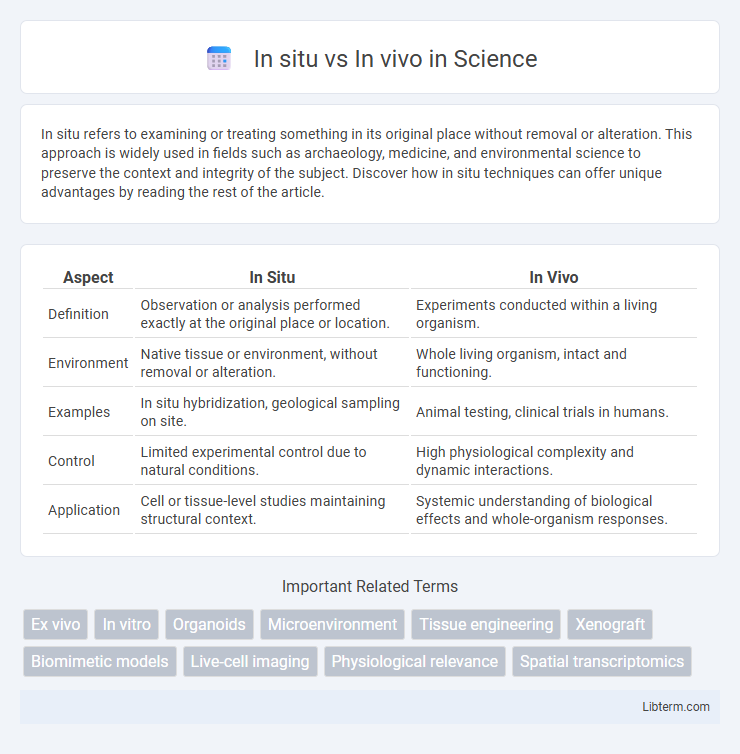In situ refers to examining or treating something in its original place without removal or alteration. This approach is widely used in fields such as archaeology, medicine, and environmental science to preserve the context and integrity of the subject. Discover how in situ techniques can offer unique advantages by reading the rest of the article.
Table of Comparison
| Aspect | In Situ | In Vivo |
|---|---|---|
| Definition | Observation or analysis performed exactly at the original place or location. | Experiments conducted within a living organism. |
| Environment | Native tissue or environment, without removal or alteration. | Whole living organism, intact and functioning. |
| Examples | In situ hybridization, geological sampling on site. | Animal testing, clinical trials in humans. |
| Control | Limited experimental control due to natural conditions. | High physiological complexity and dynamic interactions. |
| Application | Cell or tissue-level studies maintaining structural context. | Systemic understanding of biological effects and whole-organism responses. |
Introduction to In Situ and In Vivo Methods
In situ methods involve studying biological processes directly within their original location, preserving the natural environment and spatial relationships of cells or tissues. In vivo methods refer to experiments conducted within living organisms, allowing observation of complex physiological interactions in real time. Both approaches provide critical insights, with in situ offering detailed structural context and in vivo enabling dynamic assessment of biological function.
Defining In Situ: Meaning and Applications
In situ refers to analyzing or observing a process or structure exactly where it occurs, without removing it from its original environment, enabling precise spatial context and native interactions. This approach is widely applied in fields such as biology, geology, and environmental science to study cells, minerals, or pollutants in their natural settings. In situ techniques enhance understanding by preserving physiological conditions and local microenvironments critical for accurate data interpretation.
Understanding In Vivo: Concept and Scope
In vivo studies involve examining biological processes within a living organism, allowing researchers to observe complex interactions in their natural physiological context. This approach provides critical insights into systemic effects, pharmacokinetics, and toxicity that cannot be fully replicated in vitro or in situ models. Understanding the scope of in vivo experimentation is essential for developing drugs, evaluating disease mechanisms, and advancing translational medicine.
Key Differences Between In Situ and In Vivo
In situ refers to experiments conducted in the original place or natural position within an organism or environment, preserving the spatial context, while in vivo involves studies performed inside a living organism. In situ techniques allow observation of biological processes at the cellular or molecular level without disrupting the tissue architecture, whereas in vivo methods provide comprehensive insights into systemic and physiological interactions within the entire living organism. Key differences include the scale of observation, with in situ focusing on localized settings and in vivo emphasizing whole-organism responses.
Advantages of In Situ Techniques
In situ techniques offer precise spatial localization of biological processes within the natural cellular environment, enabling detailed study of molecular interactions without disrupting tissue architecture. These methods provide high-resolution visualization of gene expression and protein distribution, preserving cellular context that is often lost in in vivo experiments. In situ approaches also allow for targeted analysis in heterogeneous samples, facilitating accurate diagnosis and research on complex tissues.
Benefits and Limitations of In Vivo Studies
In vivo studies offer the benefit of observing biological processes within the complex interactions of a living organism, providing more relevant and holistic data compared to in situ experiments that focus on specific cells or tissues in controlled environments. These studies enable assessment of systemic effects, pharmacokinetics, and toxicity, which are crucial for drug development and disease modeling. However, limitations include higher ethical concerns, greater variability, increased costs, and longer study durations that can complicate data interpretation and reproducibility.
Common Fields Utilizing In Situ Methods
In situ methods are extensively utilized in fields such as environmental science, archaeology, and materials science for analyzing samples directly within their natural context without extraction. These techniques enable precise spatial resolution, preserving the structural and chemical integrity of specimens during investigation. In contrast, in vivo studies are prominent in biomedical and pharmaceutical research, focusing on observing biological processes within living organisms.
Typical Applications of In Vivo Research
In vivo research is typically employed in pharmacology to assess drug efficacy and toxicity directly within living organisms, providing vital insights into complex biological interactions that cannot be replicated in vitro. It is essential for studying disease progression, genetic functions, and immune responses in animal models, offering a realistic context for translational medicine. Common applications include toxicological assessments, pharmacokinetic studies, and behavioral experiments critical for preclinical trials and therapeutic development.
Comparative Analysis: In Situ vs In Vivo Outcomes
In situ studies provide a controlled environment for examining biological processes within their natural location, preserving tissue architecture and cellular interactions, while in vivo studies offer comprehensive insights by observing whole-organism responses and systemic effects. Comparative analysis reveals that in situ outcomes often yield detailed cellular-level information with minimal systemic variability, whereas in vivo outcomes capture complex physiological interactions and long-term effects crucial for translational research. Integrating in situ and in vivo approaches enhances the reliability of experimental data, enabling precise mechanistic understanding alongside real-world biological relevance.
Choosing the Right Approach: Factors to Consider
Choosing between in situ and in vivo approaches depends on factors such as the research objective, desired control over experimental variables, and the complexity of biological interactions. In situ techniques offer precise localization within tissue environments, ideal for studying cellular behaviors in context, while in vivo methods provide comprehensive insights into systemic responses within whole organisms. Considerations include ethical constraints, cost, technical feasibility, and the relevance of physiological conditions to ensure accurate and meaningful results.
In situ Infographic

 libterm.com
libterm.com